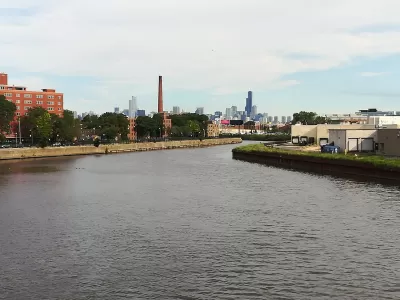The massive proposed development project on the Chicago River is facing a host of questions about density, open space, and infrastructure.

Ryan Ori reports on the Lincoln Yards development proposal in Chicago. “The developer [Sterling Bay], among the busiest in the city, is redrawing its plans in an effort to secure city zoning approval for a project that, even pared down, would be among the most ambitious mixed-use developments in the city in decades.”
The revised plan covers just over 75 percent of the 70-acre parcel. It drops the maximum building height to 650 feet, which was previously 800 feet, and increases open space from 13.4 acres to almost 21 acres.
Sterling Bay was responding to feedback after the first community meeting in July, which raised concerns about traffic, park and open space, and the effect the development would have on businesses and schools in the area. “[Alderman Brian] Hopkins said he wants to see more specifics on many aspects of the plan — including much-needed infrastructure improvements in an area already plagued by traffic congestion,” reports Ori.
Sterling Bay has discussed possible plans for building new road, transit, and other public infrastructure. “[Mayor Rahm] Emanuel’s outgoing administration recently said it wants to create sources of funding, including new tax increment financing districts to help pay for those projects,” says Ori.
The prospect of a Lincoln Yards TIF district is already generating skepticism and concern. Critics say that crucial funds will be diverted from schools and local government agencies and that the TIF plan is being pushed through too quickly before Mayor Emanuel steps down next year.
FULL STORY: Column: Lower skyscrapers, wider parks in revised Lincoln Yards proposal

Alabama: Trump Terminates Settlements for Black Communities Harmed By Raw Sewage
Trump deemed the landmark civil rights agreement “illegal DEI and environmental justice policy.”

Study: Maui’s Plan to Convert Vacation Rentals to Long-Term Housing Could Cause Nearly $1 Billion Economic Loss
The plan would reduce visitor accommodation by 25% resulting in 1,900 jobs lost.

Why Should We Subsidize Public Transportation?
Many public transit agencies face financial stress due to rising costs, declining fare revenue, and declining subsidies. Transit advocates must provide a strong business case for increasing public transit funding.

Wind Energy on the Rise Despite Federal Policy Reversal
The Trump administration is revoking federal support for renewable energy, but demand for new projects continues unabated.

Passengers Flock to Caltrain After Electrification
The new electric trains are running faster and more reliably, leading to strong ridership growth on the Bay Area rail system.

Texas Churches Rally Behind ‘Yes in God’s Back Yard’ Legislation
Religious leaders want the state to reduce zoning regulations to streamline leasing church-owned land to housing developers.
Urban Design for Planners 1: Software Tools
This six-course series explores essential urban design concepts using open source software and equips planners with the tools they need to participate fully in the urban design process.
Planning for Universal Design
Learn the tools for implementing Universal Design in planning regulations.
Caltrans
Smith Gee Studio
Institute for Housing and Urban Development Studies (IHS)
City of Grandview
Harvard GSD Executive Education
Toledo-Lucas County Plan Commissions
Salt Lake City
NYU Wagner Graduate School of Public Service




























